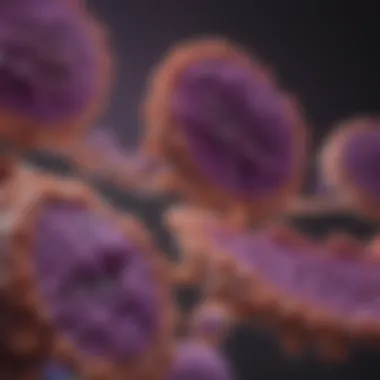Understanding Pancreatic Cancer and Its Prognosis


Intro
Pancreatic cancer presents a significant challenge in both clinical and research settings. Understanding its biological behaviors, progression, and treatment options is vital for improving patient outcomes. This section introduces the fundamentals of pancreatic cancer and outlines its relevance in the modern medical landscape.
Overview of Research Topic
Brief Background and Context
Pancreatic cancer arises from the tissues of the pancreas, an organ essential for digestion and regulating blood sugar levels. This type of cancer is notorious for its late diagnosis and poor prognosis. The most commonly diagnosed type is pancreatic ductal adenocarcinoma, accounting for approximately 85% of cases. It has relatively low survival rates compared to other cancers, with a five-year survival rate of around 10%. The elusive nature of early detection contributes to the high fatality rate.
Importance in Current Scientific Landscape
The significance of studying pancreatic cancer cannot be overstated. As the world faces rising cancer incidence, pancreatic cancer remains a critical area of research. Advances in genetics, imaging techniques, and treatment strategies hold promise for enhancing early detection and treatment options.
Given the high mortality rate, improving our understanding of pancreatic cancer is essential for developing better screening techniques and therapies. Research initiatives focus on molecular pathways, immunotherapy, and targeted therapies to modify the course of the disease.
"The future of pancreatic cancer treatment relies heavily on understanding its unique characteristics and identifying new therapeutic targets."
Methodology
Research Design and Approach
This article synthesizes existing research to provide a comprehensive overview of pancreatic cancer. It examines key studies, statistical analyses, and literature reviews from various sources. The focus is on identifying critical factors influencing prognosis and survival rates.
Data Collection Techniques
To compile relevant data, sources include peer-reviewed journals, clinical trials, and cancer registries. By analyzing patient outcomes, treatment efficacy, and ongoing research, we can gain insights into the complexities of the disease.
Through systematic investigation, this article aims to educate readers on the multifaceted aspects of pancreatic cancer, ranging from diagnosis to treatment strategies.
Prolusion to Pancreatic Cancer
Understanding pancreatic cancer is critical for grasping the broader implications of this disease on public health. It is known as one of the deadliest forms of cancer, often diagnosed at advanced stages, which significantly impacts prognosis. This section seeks to illuminate the foundational elements of pancreatic cancer, including its definition and classification, as well as key epidemiological data that reflects its prevalence and outcomes in various demographics.
Definition and Types
Pancreatic cancer primarily refers to the malignancies that arise from the tissues of the pancreas. The most common type is adenocarcinoma, accounting for about 95% of all pancreatic cancer cases. It typically begins in the cells lining the ducts of the pancreas. Less prevalent types include neuroendocrine tumors, which can originate from the hormone-producing cells of the pancreas. Additionally, acinar cell carcinoma, though rarer, also poses significant health risks. Each type exhibits distinct biological characteristics and treatment responses, thereby necessitating a thorough understanding for effective management.
Epidemiology
The epidemiology of pancreatic cancer reveals a concerning picture. According to statistics, the lifetime risk of developing pancreatic cancer is about 1 in 64 in the United States. The incidence varies significantly by region; however, it tends to be higher in developed countries compared to developing ones. Age is a considerable factor, as the vast majority of diagnoses occur in individuals over 65 years of age. Moreover, there is a notable racial disparity, with African Americans experiencing a higher incidence and mortality rate.
Pancreatic cancer ranks as the fourth leading cause of cancer-related death in the United States, underscoring its severity.
Understanding these epidemiological trends emphasizes the urgent need for heightened awareness, early detection, and innovative treatment methods. As public health initiatives strive to address these trends, individuals and families traversing this diagnosis must navigate a complex landscape of medical information and support.
Understanding the Pancreas
The pancreas plays a vital role in our overall health. Understanding its structure and functions is important, especially when discussing pancreatic cancer. This knowledge helps to clarify how the disease affects the body and why certain treatment options are pursued. The pancreas is a unique organ, functioning both as an endocrine and exocrine gland. This duality directly impacts how diseases like pancreatic cancer develop and present.
Anatomy and Function
The pancreas is located behind the stomach and is about six inches long. It comprises three main parts: the head, body, and tail. Blood flow to this organ comes from the celiac trunk and the superior mesenteric artery. The head of the pancreas is where most cancers occur. Its anatomy allows for several important functions.


The exocrine part of the pancreas produces digestive enzymes, which are crucial for breaking down carbohydrates, proteins, and fats. These enzymes include amylase, lipase, and proteases. They are delivered to the small intestine through the pancreatic duct. This function directly relates to digestion.
The pancreas also has an endocrine component. Cells called islets of Langerhans produce hormones such as insulin and glucagon. These hormones regulate blood sugar levels, showing the significance of the pancreas in metabolic processes. When pancreatic cancer disrupts these functions, patients can face severe symptoms and complications that affect their quality of life.
Role in Digestion and Hormone Regulation
The pancreas is integral to digestion. The enzymes produced help convert food into nutrient molecules, which are then absorbed by the body. A malfunction here can lead to malabsorption, where the body fails to absorb nutrients properly, resulting in weight loss and malnutrition.
In terms of hormone regulation, the balance of insulin and glucagon is key to maintaining homeostasis in blood glucose levels. For instance, a decrease in insulin production can lead to diabetes, a condition that may arise if pancreatic cancer affects the islet cells. This interaction between digestion and hormone secretion showcases the complexity of the pancreatic function.
"An understanding of the pancreas is crucial when discussing pancreatic cancer, as it highlights the relationship between this organ’s functionality and the implications of cancerous growth."
Moreover, the pancreas does not have a large reserve capacity, meaning any loss of function can have more immediate and severe effects on a person’s health. Knowledge of pancreatic anatomy and its roles helps in comprehending the clinical aspects of pancreatic cancer, which affects thousands each year. By understanding the pancreas, its significance in digestion and hormonal production becomes evident, further underlining why pancreatic cancer poses such significant health risks.
The Significance of Early Diagnosis
Early diagnosis of pancreatic cancer is crucial. The earlier the cancer is detected, the better the chances of successful treatment and improved patient outcomes. This significance stems from the often asymptomatic nature of the disease in its initial stages. Many patients do not experience noticeable symptoms until the cancer has progressed significantly. This delay in diagnosis contributes to the high mortality rates associated with pancreatic cancer. Understanding the symptoms and risk factors, as well as the diagnostic techniques available, can greatly influence a patient’s prognosis.
Symptoms and Risk Factors
Recognizing symptoms of pancreatic cancer early can be life-saving. Some common symptoms include:
- Abdominal pain that often radiates to the back.
- Unexplained weight loss without changes to diet or exercise.
- Loss of appetite and feeling full after eating only a small amount of food.
- Jaundice, which is a yellowing of the skin and eyes, often indicating bile duct obstruction.
- Fatigue and nausea.
However, these symptoms are often vague and can easily be attributed to other non-cancerous conditions. Thus, it is essential for patients, especially those with risk factors, to seek medical advice promptly. Risk factors that increase the likelihood of developing pancreatic cancer include:
- Age, as the risk increases significantly for individuals over 60.
- A family history of pancreatic cancer or genetic syndromes such as BRCA mutations.
- Smoking, which is one of the most significant modifiable risk factors.
- Obesity and chronic conditions such as diabetes or pancreatitis.
Diagnostic Techniques
A variety of diagnostic techniques exist to confirm the presence of pancreatic cancer. These techniques can differ in invasiveness and yield different types of information:
- Imaging tests like CT scans, MRI, and ultrasound help visualize the pancreas and surrounding structures. They can identify masses, changes in the pancreas, and spread to nearby organs.
- Endoscopic ultrasound (EUS) allows for detailed imaging and the possibility of biopsying suspicious areas.
- Biopsy remains the gold standard for diagnosis, where tissue samples from the pancreas can confirm the presence of cancerous cells.
- Blood tests can measure specific markers such as CA19-9, although this is not definitive for diagnosis.
Staging of Pancreatic Cancer
Staging of pancreatic cancer is crucial in determining the course of treatment and the overall prognosis for patients. The stage of cancer refers to how far the disease has progressed. It can significantly influence treatment decisions and strategies for managing the disease. Understanding the stages helps healthcare professionals provide a clearer overview of what to expect throughout the treatment journey.
Cancer staging typically encompasses several key elements, including the size of the tumor, whether it has spread to nearby lymph nodes, and if distant organs are affected. This categorization enables oncologists to assess the aggressiveness of the cancer. It also aids in the identification of how much the disease may potentially grow or spread.
Additionally, accurate staging is beneficial not only for designing an effective treatment plan but also for assisting patients and their families in making informed decisions.
Stages and Classification
Pancreatic cancer is commonly classified using the TNM system, which considers three main factors: Tumor (T), Nodes (N), and Metastasis (M).
- Tumor (T): Indicates the size and extent of the main tumor. It ranges from T1, where the tumor is small and localized, to T4, where the tumor is large or has grown into nearby structures.
- Nodes (N): Reflects whether the cancer has spread to nearby lymph nodes. It can range from N0, indicating no lymph node involvement, to N1, suggesting the presence of cancer in these nodes.
- Metastasis (M): Determines whether cancer has spread to distant parts of the body. M0 indicates no distant metastasis, while M1 indicates that metastasis has occurred.
Based on these classifications, pancreatic cancer is then categorized into one of four stages:
- Stage 0: Abnormal cells are found in the pancreas but not spread.
- Stage I: Cancer is localized within the pancreas and has not spread to lymph nodes.
- Stage II: Cancer may have spread to nearby lymph nodes but remains in the pancreas.
- Stage III: Cancer has invaded nearby blood vessels or nerves and may have spread to lymph nodes.
- Stage IV: Cancer has spread to distant organs such as the liver or lungs.
Each stage implicates different treatment approaches and corresponding survival rates, crucial for patient management and expectations.
Importance of Staging for Prognosis


Knowing the stage of pancreatic cancer carries significant weight regarding the prognosis, as it helps predict the outcome for the patient. Generally, earlier stages have a better prognosis than later stages.
- Survival Rates: Statistics indicate that individuals diagnosed at Stage I have considerably higher five-year survival rates compared to those diagnosed at Stage IV, where the prognosis remains grim.
- Tailored Treatment: Staging aids in the creation of personalized treatment plans. For example, patients with localized cancer may benefit from surgical interventions, while advanced-stage patients may need more aggressive treatment like chemotherapy.
- Treatment Objectives: Understanding the extent of the disease can shift the objective of treatment from curative to palliative, ensuring patients receive the most appropriate care for their situation.
Treatment Options for Pancreatic Cancer
Treatment options for pancreatic cancer hold significant importance, not only for improving survival rates but also for enhancing the quality of life for patients. The multifaceted nature of the disease necessitates a tailored approach that considers the unique characteristics of each patient, including the stage of cancer, overall health, and personal preferences. In this section, we will examine the primary treatment modalities, including surgical interventions, chemotherapy, radiation therapy, and the potential of emerging treatments and clinical trials.
Surgical Interventions
Surgical intervention is often the first line of treatment for pancreatic cancer, particularly in cases where the cancer has not metastasized. The most common surgical procedure is the Whipple procedure, or pancreaticoduodenectomy, which involves the removal of the head of the pancreas, the duodenum, a portion of the stomach, and nearby lymph nodes. This surgery can potentially cure early-stage pancreatic cancer.
However, not all patients are candidates for surgery. Factors such as tumor size, location, and metastatic spread must be considered. Patients who undergo surgery may experience postoperative complications, and recovery can be challenging. Therefore, a thorough evaluation by a multidisciplinary team of healthcare professionals is essential to determine the appropriateness of surgical intervention.
Chemotherapy and Radiation Therapy
Chemotherapy and radiation therapy are typically used when surgery is not an option or as adjuvant treatments following surgical intervention. Chemotherapy involves the use of drugs to kill cancer cells or inhibit their growth. Drugs such as gemcitabine or FOLFIRINOX are commonly used regimens. These treatments can reduce tumor size and may improve survival rates, though they come with side effects, including fatigue, nausea, and risk of infection.
Radiation therapy can target and kill cancer cells while minimizing damage to surrounding tissues. It may be used in combination with chemotherapy to enhance effectiveness. For some patients, radiation therapy may serve as palliative care to relieve symptoms and improve quality of life. Understanding how these treatments work together is vital for patient education and awareness.
Emerging Treatments and Clinical Trials
The landscape of pancreatic cancer treatment is evolving, with ongoing research focusing on new therapies and clinical trials. Immunotherapy represents one promising area of exploration. This approach aims to harness and enhance the body's immune system to recognize and combat cancer cells. Another focus has been on targeted therapies which attack specific genetic mutations caused by cancer. For instance, treatments targeting the BRCA gene mutations can show effectiveness in certain patients.
Additionally, clinical trials are imperative for testing the efficacy and safety of new medications or combinations of existing therapies. Participation in clinical trials can provide patients access to cutting-edge treatments that may not yet be widely available.
"Emerging treatments and targeted therapies hold promise for potentially improving outcomes for patients with pancreatic cancer."
As the field advances, staying informed about ongoing research and available trials is crucial for patients seeking the most effective treatment options. Each treatment plan should be designed based on the individual patient's condition, with a comprehensive understanding of the associated risks and benefits.
In summary, the treatment options for pancreatic cancer are diverse and continually changing. From surgical intervention to chemotherapy and investigation into new therapies, the goal is to ultimately improve patient outcomes and quality of life. By understanding these options, patients and their families can make informed decisions about their treatment pathways.
Survival Rates and Prognosis
The discussion on survival rates and prognosis is paramount in understanding pancreatic cancer. Prognosis is the medical term used to describe the likely course and outcome of a disease. In the context of pancreatic cancer, this includes survival rates, which are vital statistics used by patients and healthcare professionals alike to gauge expectations and inform treatment decisions. Understanding these rates allows for better preparedness and realistic assessment of personal circumstances.
Statistical data serves as a foundation for comprehending how pancreatic cancer can progress. However, these numbers can often be daunting and may not accurately reflect individual circumstances. As we explore survival rates and their implications, it is essential to consider various factors influencing these outcomes.
Statistical Overview
Survival rates for pancreatic cancer are generally measured in five-year increments. This means that they indicate the percentage of people who live at least five years after their diagnosis. According to various studies, the five-year survival rate for pancreatic cancer hovers around 10-11%. This figure is alarming but represents aggregate data. It is essential to view it with a critical lens, as outcomes differ vastly among individuals based on several factors.
Key statistics for pancreatic cancer include:
- Localized tumor: When caught in the early stage, the five-year survival rate may be as high as 39%. This emphasizes the importance of early detection.
- Regional tumor: For cases where cancer has spread to nearby structures, the rate drops significantly to about 13%.
- Distant metastasis: Unfortunately, if cancer has metastasized to distant organs, the five-year survival rate plummets to around 3%.
Survival statistics are crucial for research and clinical practice. They can inform therapeutic strategies and influence decisions regarding treatments, participation in clinical trials, and even lifestyle changes.
Factors Influencing Prognosis
Several factors can shape the prognosis of a patient diagnosed with pancreatic cancer. These factors include:
- Tumor Stage and Size: The stage at diagnosis is one of the most significant predictors. Earlier stages respond better to treatments.
- Patient’s Age: Younger patients often have better prognostic outcomes than older ones, primarily due to better overall health and resilience.
- Treatment Options: Availability and selection of treatments, including surgery, chemotherapy, and radiation, play a vital role. More aggressive and timely treatment approaches can enhance survival.
- Location of Tumor: Tumors located in the head of the pancreas may present different challenges compared to those in the body or tail.
- Genetic Factors: Certain genetic mutations, such as BRCA mutations, can affect the response to treatments. These may provide opportunities for personalized approaches.
- Overall Health Condition: Co-existing health issues can worsen the prognosis and complicate treatment.


As highlighted, prognosis in pancreatic cancer is multi-factorial. While statistics provide a general framework, personalizing treatment based on individual characteristics is vital for improving outcomes and survival rates.
Living with Pancreatic Cancer
Living with pancreatic cancer presents numerous challenges and complexities that affect not only the patients but also their families and caregivers. Understanding these challenges is vital for both the emotional well-being and the overall management of the disease. The importance of this section lies in addressing the daily realities faced by individuals diagnosed with this condition, as well as the strategies that can aid in coping with the associated physical and emotional impacts.
Patient Experiences and Emotional Impact
Patients diagnosed with pancreatic cancer often encounter a range of emotional responses. Feelings such as anxiety, fear, and depression can emerge, stemming from uncertainties about treatment, prognosis, and the future. These sentiments are not uncommon given the disease's aggressive nature and the often-limited options available. Individuals may undergo profound changes in their sense of identity, relationships, and outlook on life.
A qualitative approach to understanding these experiences can offer insights into their emotional landscape. Many patients report feelings of isolation, perhaps due to changes in social dynamics or the stigma associated with cancer. Engaging with others who share similar experiences, whether through support groups or online forums, can alleviate this sense of loneliness, fostering a sense of community and understanding.
It's essential to recognize the impact of a cancer diagnosis not just on physical health but also on mental health. Psychological support, including counseling and therapies, can play a crucial role in helping patients navigate their feelings. These resources can provide coping strategies and facilitate discussions about fears and concerns surrounding illness and treatment. This support ultimately enhances the quality of life for patients, allowing them to better manage their journey.
Support Systems and Resources
Establishing a robust support system is crucial when living with pancreatic cancer. This support can come from family, friends, healthcare providers, and community resources. Each of these components plays a different but equally important role in the journey of the patient.
- Family and Friends: Loved ones provide emotional support, which is crucial. Their involvement can encourage positive interactions and combat feelings of isolation.
- Healthcare Professionals: A multidisciplinary healthcare team, including doctors, nurses, social workers, and nutritionists, can provide comprehensive care. Regular communication with this team can lead to better management of symptoms and side effects.
- Support Groups: Joining support groups dedicated to pancreatic cancer can provide patients and their families with tools to cope with their diagnosis. These groups can offer practical advice and emotional support, where members share their journeys, and struggles, and successes.
- Online Resources: Many organizations offer extensive information about pancreatic cancer. Websites like Wikipedia and Britannica provide foundational knowledge, while forums on platforms like Reddit allow for conversation and experience sharing among peers.
"Having a solid support system can transform the experience of living with pancreatic cancer from one of isolation to a path of shared understanding and resilience."
Developing a network that provides emotional and practical support can make a significant difference in the day-to-day experience of patients, enhancing their resilience and ability to face the challenges ahead.
Research and Future Directions
Research in pancreatic cancer is crucial for several reasons. The disease has historically been associated with poor outcomes, reflecting the urgent need for improved understanding and novel approaches. Advances in research can lead not only to a better understanding of the biology of pancreatic cancer but also to the development of effective treatment strategies. This section aims to illuminate the ongoing efforts in this field and their implications for patients.
Current Research Trends
Today, investigations into pancreatic cancer focus on various fronts:
- Genomics and Molecular Biology: Researchers are exploring genetic mutations linked to pancreatic cancer, like KRAS. Understanding these alterations can help in identifying specific targets for therapy.
- Immunotherapy: There is growing interest in harnessing the immune system to combat pancreatic cancer. Studies are evaluating checkpoint inhibitors and vaccine approaches to boost immune response against cancer cells.
- Biomarkers: The identification of biomarkers for early detection is a critical focus. Blood tests and imaging techniques are being researched to indicate the presence of pancreatic cancer earlier, potentially leading to better prognoses.
- Combination Therapies: Research is increasingly examining the effects of combining different treatment modalities, such as chemotherapy with targeted therapy or radiation, to enhance effectiveness.
These trends reflect a shift towards personalized medicine, where treatment can be tailored to individuals based on their specific cancer profile.
Potential for New Treatments
The pursuit of new treatments for pancreatic cancer holds tremendous potential. The landscape is rapidly evolving, and several promising avenues are emerging:
- Targeted Therapies: Advances in understanding the specific pathways involved in pancreatic cancer have led to the development of drugs that target these pathways. Compounds that inhibit the action of mutated proteins are being tested.
- Enhanced Chemotherapy Regimens: Ongoing trials with novel combinations or improved delivery methods aim to make chemotherapy more effective and reduce side effects.
- Nanotechnology: This approach allows for targeted drug delivery systems, which can minimize damage to healthy cells while maximizing the therapeutic effect on tumors.
- Gene Therapy: Techniques aiming to correct defective genes or introduce new genes to combat cancer are under active investigation and show promise in preliminary studies.
As these research efforts advance, it is crucial to remain optimistic but realistic about their future impact on treatment options and patient outcomes. Continuous collaboration between researchers, clinicians, and patients is essential for translating findings into clinical practice.
Finale
The conclusion of this article focuses on the vital aspects of pancreatic cancer and its prognosis, summarizing the complexities discussed throughout. Understanding the intricacies of pancreatic cancer is crucial not only for medical professionals but also for patients and their families. Recognizing the disease's biological behavior, risk factors, and the implications of timely diagnosis is essential for informed decision-making.
Summary of Key Points
In summary, pancreatic cancer presents significant challenges, and several key points arise from our discussion:
- Definition and Types: Pancreatic cancer includes distinct types like adenocarcinoma and neuroendocrine tumors.
- Epidemiology: This disease is on the rise globally, with certain populations more affected than others.
- Significance of Early Diagnosis: Identifying symptoms and employing diagnostic techniques early are critical for improving outcomes.
- Staging: Accurate staging is integral for determining appropriate treatment options and overall prognosis.
- Treatment Options: The landscape of treatment for pancreatic cancer is evolving, relying on surgical options, chemotherapy, and emerging therapies.
- Survival Rates: Statistical insights reveal a generally bleak prognosis, heavily influenced by various factors.
- Living with the Disease: Emotional impacts and support systems play an essential role in enhancing patients' quality of life.
- Future Directions: Cutting-edge research and clinical trials offer hope for new treatments and improved prognostic tools.
Final Thoughts on Prognosis
The prognosis for pancreatic cancer remains challenging. Survival rates are generally low, but individual outcomes can vary dramatically based on numerous factors such as the stage at diagnosis, the effectiveness of the treatment administered, and the patient's overall health.
"Awareness of the factors affecting outcomes is as crucial as the treatment options available."
Continued research into the biology of pancreatic cancer and efforts to innovate treatment protocols are essential. This ongoing quest may ultimately lead to better survival rates and improved patient experiences.



